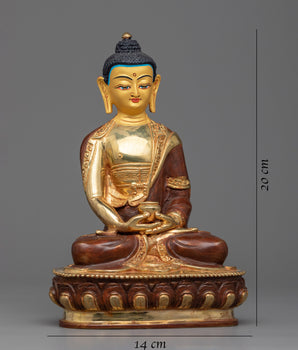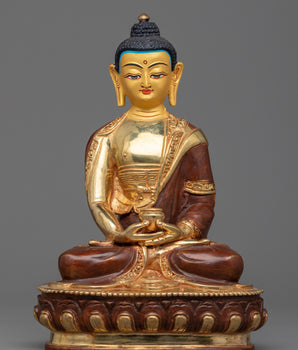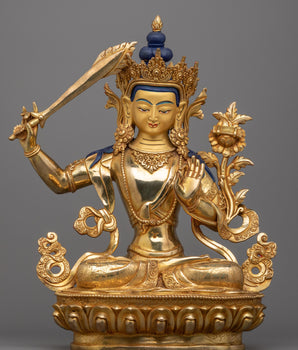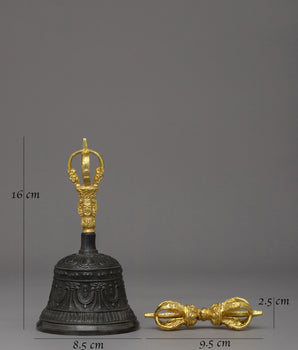In the rich iconographic tradition of Tibetan Buddhism, the elephant emerges as a potent symbol across thangka paintings, statues and ritual contexts. This article explores the many layers of meaning behind the elephant — how it is depicted, what it represents, and which deities it is associated with.
By weaving together art (thangka and sculpture), textual symbolism, and devotional practice, we gain a deeper appreciation of this majestic creature as more than an animal: in Tibetan Buddhism it becomes a bridge to mind‑training, spiritual fortitude and divine presence. 
Symbolic Meaning of the Elephant in Tibetan Buddhism
Elephant as the Mind and Meditation Metaphor
According to Tibetan Buddhist art and commentary, the elephant commonly stands for the mind — especially in meditative contexts. In the classic “Way to Heaven” thangka of the nine‑stage samatha meditation, the elephant begins wild and black, representing the untamed mind. Gradually it is calmed, turns white, and becomes the faithful companion of the meditator.
The widespread use of the elephant as symbol of the mind which, when disciplined, can serve its master (the meditator) as no other animal can.
White Elephant: Purity, Royalty & Auspiciousness
The white elephant holds special significance in Tibetan Buddhist symbolism. It is noted as an auspicious emblem associated with royalty, spiritual power and the direct link to the sacred realm.
For example, the dream of Queen Maya (mother of the Buddha) features a white elephant entering her womb, symbolising the imminent birth of an awakened being.
Elephant as Vehicle and Strength Symbol
Beyond meditation metaphor, elephants serve as vehicles (vahana) of certain deities or Bodhisattvas in Tibetan iconography: strength, stability, and the capacity to carry the Dharma are all implicit. The elephant’s large footprint, slow grace, and massive strength become metaphors for the mind transformed, the powerful path of practice.
Deities and Bodhisattvas Associated with the Elephant
1. Samantabhadra (Kuntu Zangpo) on the Six‑Tusked White Elephant
In Mahāyāna and Tibetan Buddhist iconography, Samantabhadra is often depicted on a six‑tusked white elephant. The mount symbolises his universal compassion, his faith, his activity in the Dharma realm.
In Tibetan practice, Samantabhadra (Kuntu Zangpo) as the dharmakāya essence may ride this elephant in symbolic form: the elephant’s calm power supports the Bodhisattva’s unimpeded activity. This is an example of the elephant serving not simply as an animal but as a symbol of awakened qualities. 
2. Indra (Sakra) riding multi-headed Elephant
Indra is traditionally shown riding the white elephant Airāvatā (or similar celestial elephant) in Buddhist/Hindu derived iconography, symbolising sovereignty, heavenly power and the majestic vehicle of a god.
Although Indra is more often rooted in Hindu cosmology, his adoption into Buddhist art (including Vajrayāna & Himalayan contexts) makes him a valid example of “deity mounted on elephant” for comparative symbolism (royal vehicle, celestial status, elephant as mount/vehicle)
3. Way to Heaven (Samatha Meditation) Thangka
In the traditional Tibetan thangka painting of the Samatha (calm‑abiding) meditation path, the elephant figures as a powerful and multilayered symbol: it represents the meditator’s own mind — initially wild, heavy, and distracted. At the beginning of the journey the elephant is shown in dark or murky colour‑tones, signalling the lethargy, dullness and wandering nature of untrained mind.
As the meditator (often depicted as a monk) progresses, the elephant gradually becomes lighter in colour, signifying that the mind is becoming clearer, more composed and under the meditator’s direction.
Read More about Nine Stages of Samatha Meditation Thangka
4. Four Harmonious Friends Thangka
In the beloved Buddhist parable known in Nepal, Tibet and Bhutan as the Four Harmonious Friends (also called Four Harmonious Animals), the elephant plays a unique and deeply symbolic role.
Within the narrative, four creatures—bird, rabbit, monkey and elephant—stand atop one another so that all may reach the fruits of a tree, each helping the other. The elephant, as the largest and strongest, forms the base of this stack. He symbolises physical strength, steadfastness, and the capacity to support others. Because the elephant carries the weight of the others and enables the collective success, it underlines the idea that true strength lies not only in size or power, but in the willingness to serve and uplift the community. 
Read More about Four Harmonious Friends
5.The Elephant as The Seven Possessions of the Chakravartin (Universal Monarch)
In the Buddhist and Indian royal‑cosmic tradition of the universal monarch (chakravartin), one of his famed Seven Precious Possessions (Sanskrit saptaratna) is the precious elephant (Sanskrit hastiratna). Below is a detailed exposition of this symbol — what the elephant stands for, how it is described, and how it functions in the metaphor of enlightened kingship. 
The seven treasures of the chakravartin are:
-
Precious Wheel (cakraratna)
-
Precious Jewel (maṇiratna)
-
Precious Queen (strīratna)
-
Precious Minister (puruṣaratna / pariṇāyakaratna)
-
Precious Elephant (hastiratna)
-
Precious Horse (aśvaratna)
-
Precious General (khaḍgaratna / senāpatiratna)
The elephant represents the trait of mindful awareness or mindfulness in Buddhist mapping: as one commentary states:
“The precious elephant from among the seven limbs of awakening: represents the faculty of mindfulness, which is a mind kept tranquil and always consciously aware of what is going on.”
6. Elephant Skin As Ornaments of Wrathful Deities:
In Tibetan‑Buddhist and Vajrayāna iconography, many wrathful deities (Singhamukha, Vajrakilaya) are depicted wearing the flayed skin of an elephant (or elephant‑hide mantle) as part of their adornment. This vivid symbolic element carries profound meaning. Below is a breakdown of its significance.
“Wrathful deities often wear the blood‑stained skin of a freshly killed elephant … The symbolism of the flayed skin refers to the deity ‘having torn the elephant of ignorance asunder’.  Singhamukha wearing Flayed Elephant Skin: Depiction in Thangka
Singhamukha wearing Flayed Elephant Skin: Depiction in Thangka












